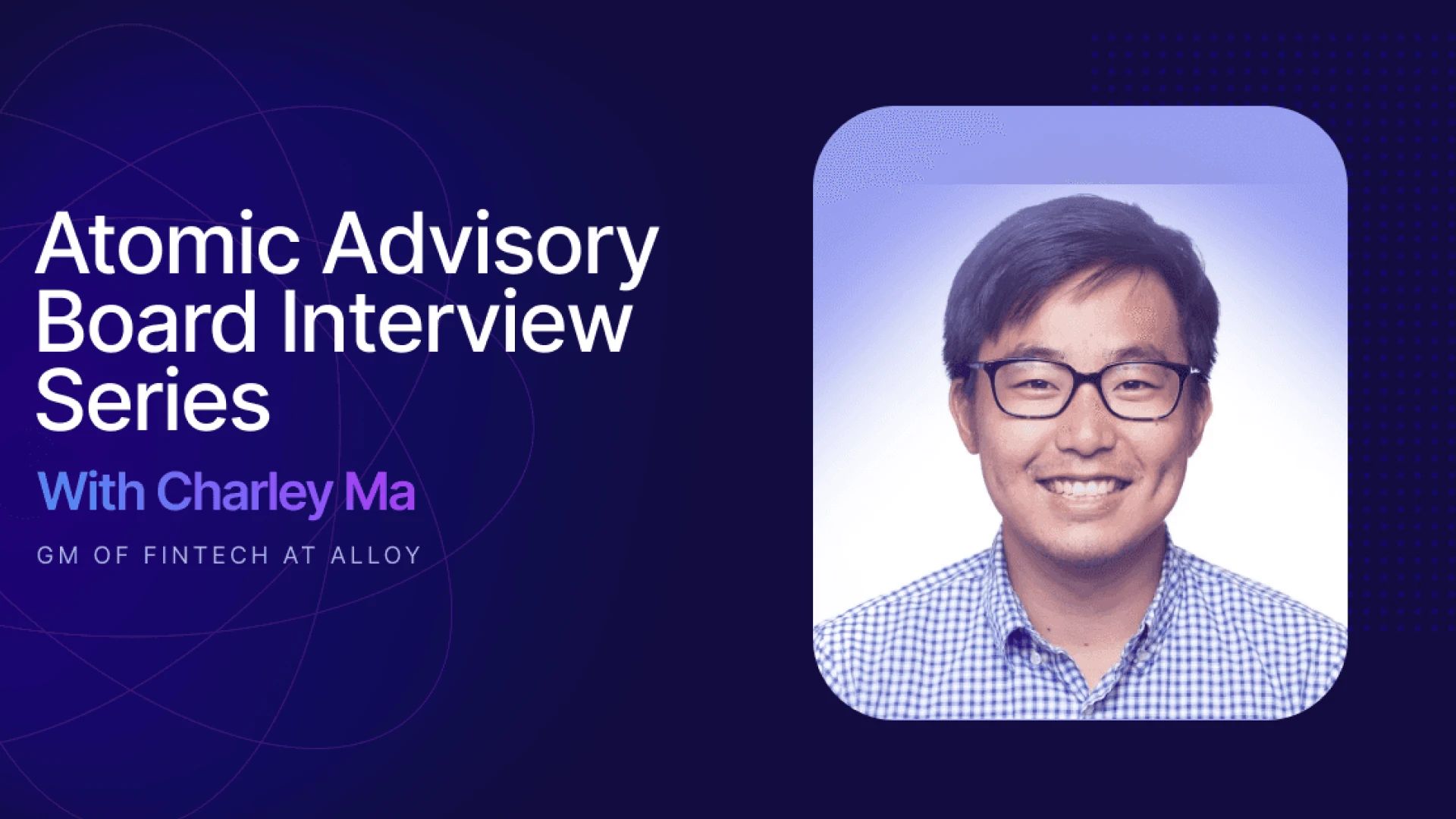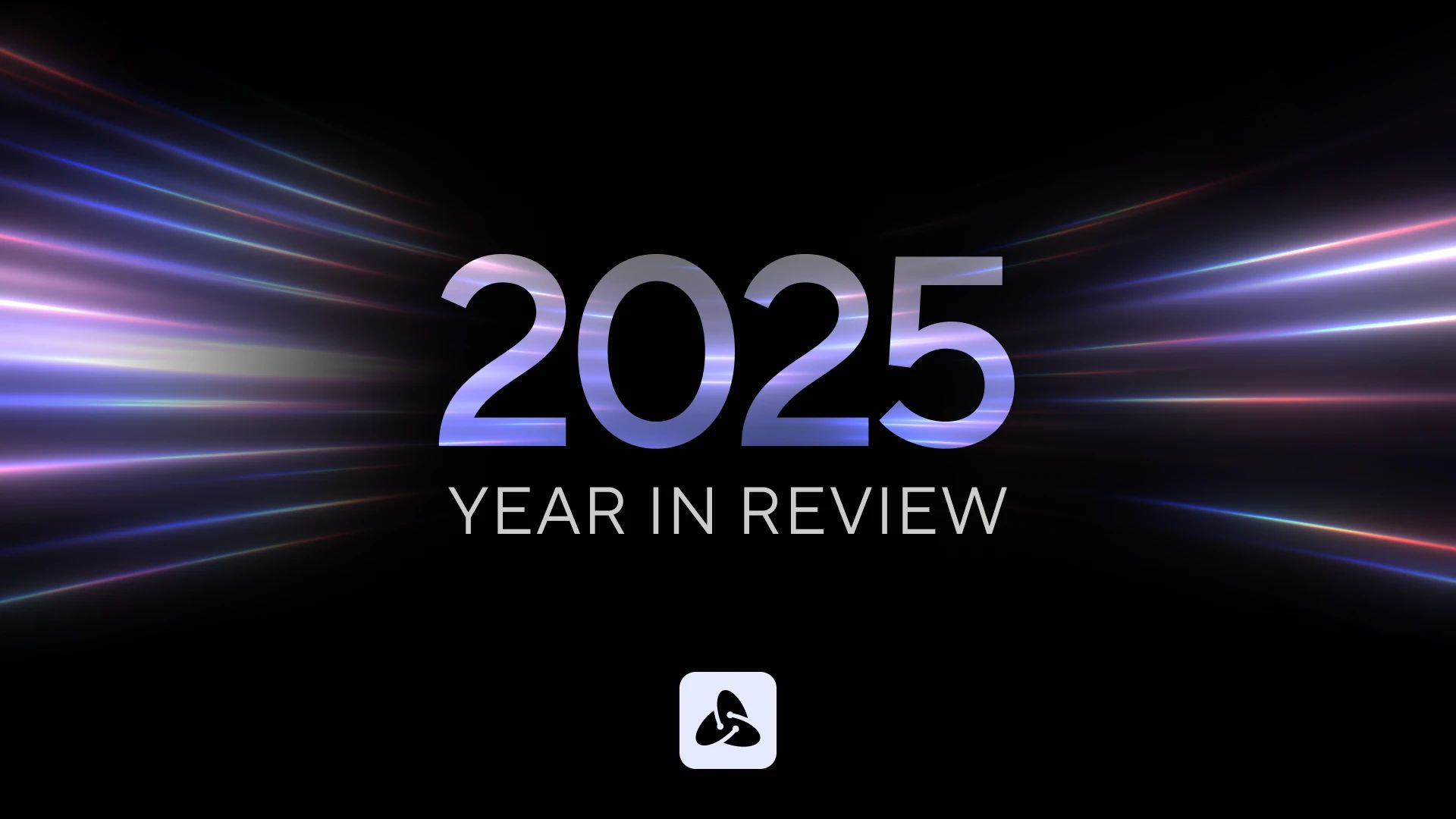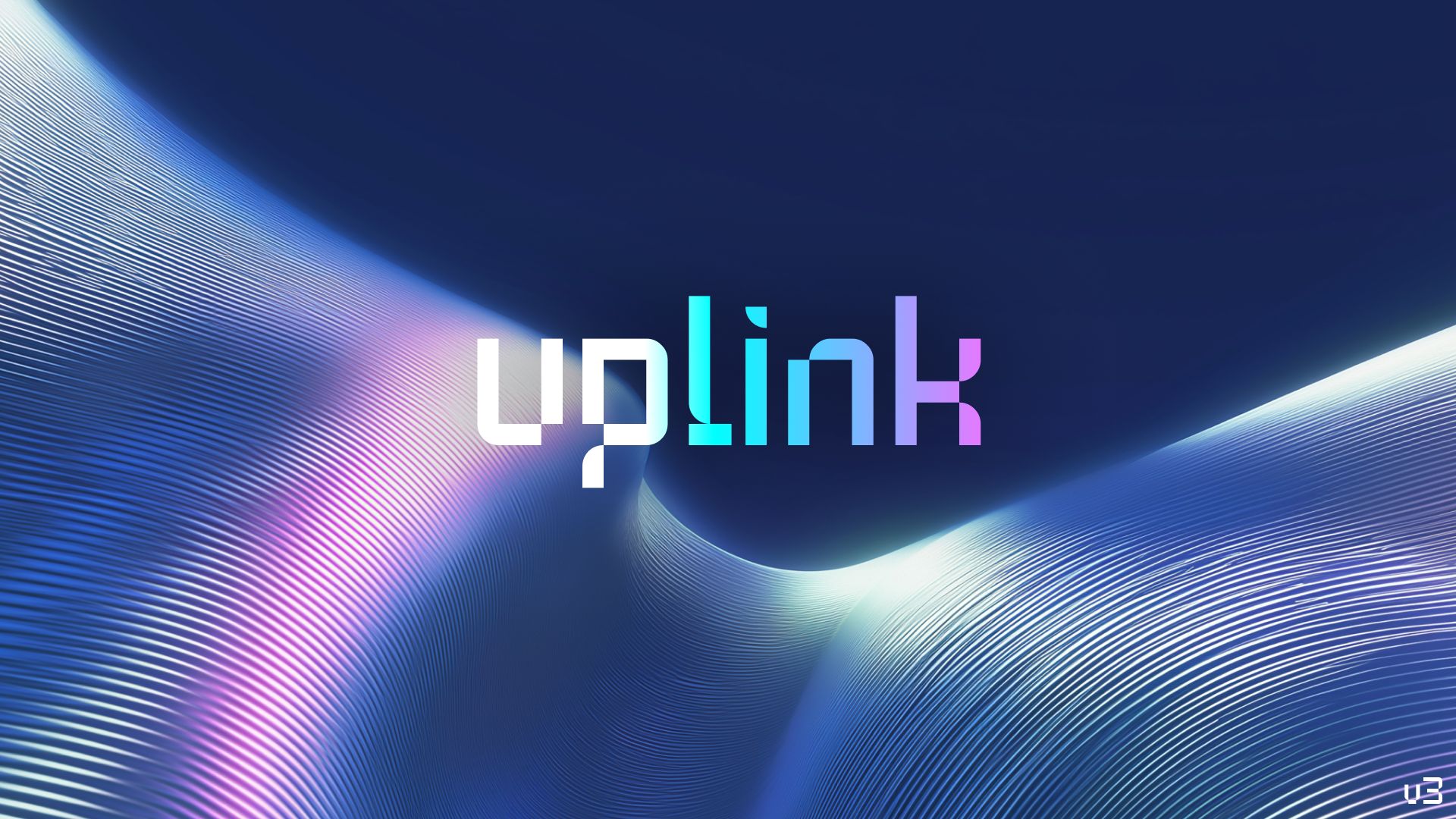What it takes to build a B2B fintech that wins

Lindsay Davis
Head of Markets

Our conversation with Charley Ma, Atomic advisory board member on where financial infrastructure can still be improved, redesigned, and disrupted by innovative startups.
Charley Ma was working at JPMorgan Chase in 2015 when he learned he’d landed a new job: he’d be the first business hire at a fintech infrastructure startup called Plaid. Obviously, the move was a savvy one for both Plaid and Ma. In his five years at the startup, he helped grow Plaid — which allows applications to seamlessly connect to users’ bank accounts — into a fintech unicorn. In 2020, he headed over to Ramp, helping the burgeoning corporate credit card startup grow to 100s of clients over the course of a year. Now, he’s moved onto the position of GM of Fintech at Alloy, an identity decisioning platform, which has also begun to rapidly grow.
Ma has seen the rise of fintech from the dead center of the industry and has a uni que perspective on where the market is going and what the customers of the future will be asking for.
This year, Ma accepted a spot on the Atomic Advisory Board. We gave him a call to learn more about what it takes to build a B2B fintech that wins and where financial infrastructure can still be improved, redesigned, and disrupted by innovative startups.
Your CV — at Plaid, then Ramp, and now Alloy — is a fascinating timeline of fintech innovation in infrastructure spreading from banking, to small business, and personal finance pain points. When fintech founders find initial product market fit, should they double down on the initial problem set or be flexible and follow pull from the market or customers?
I think it’s both. My bias tends to be toward B2B fintech problems — B2C products like Snapchat or TikTok still feel a bit magical to me. Like, I have no clue on how I would ever come up with that as a problem set?
My general framework is that once you get to product-market fit, you have to start asking: how do you continuously add tons of value into your customer relationships?
The end goal is to understand your customers front and back so you can have an understanding of their priorities and what problems they face. If you have an interesting new product or a solution that solves a huge pain point for them, then they’re coming back to you every time. If you’re then accumulating that value over time, you’re going to win in your market.
There are always question marks as to: how big is the market? How many customers have that problem set? That’s a different conversation and can be a useful way to understand the limit on how big you can get. But when you’re starting off, the key is to find hair on fire problem sets, have a 100x better product solution around that problem set, and then accumulate value over time. That’s why I say that it’s a bit of both: you can’t have the product and then just sit on it. If you find a market that’s big and interesting, there’s always going to be competition in that market. Honestly, if you’re the only company in the market, then I’d probably be a little bit concerned.
Nowadays, a lot of it’s a popular narrative that Plaid entered a completely empty greenspace when we launched. A lot of people don’t remember how competitive the market was when we officially came out of beta in 2015. There were a ton of other startups, there were large incumbents — Intuit, Finicity, Yodlee, etc.
Plaid even had a notoriously difficult series A round because a lot of investors didn’t believe fintech was a big enough market and we weren’t the obvious winner.
Obviously, the team ended up executing really, really well, but also our framework was very much: we’re going to make sure that our customers love us, make sure that we’re continuously delivering value, and make sure that we are our customer’s favorite partner. Any time they have a key priority issue, we want the first swing at solving it for them. If you have that, then you have an interesting and durable advantage.
Interest in infrastructure investing has certainly grown substantially since Plaid’s Series A — do you expect the next wave of investing to trend towards companies innovating on top of new infrastructure players?
Well, initially, we saw the v1 wave of infrastructure. Plaid is still very much in the mix, but for example you had a lot of companies built on top of v1 issuers, you had all your banking-as-a-service providers, you had that first wave of infrastructure that enabled founders to start to think: “maybe I could launch a banking product.” Now that initial playbook has been written and existing infrastructure means the path has been paved.
If you talk to the Simple founders (one of the first true neobank startups in the US), it took them years before they were able to get their first bank account live and get a debit card issued. Whereas, at my previous company Ramp, we were able to get a fully operational, fully fledged, competitive corporate card to market in under a year, which is pretty wild.
So, I think we’re going to see a ton of innovation in both B2B and B2C fintech — just lots of better financial products, which is pretty exciting!
That being said, I do believe there’s still a lot of opportunity on the infrastructure side. It’s been streamlined, but it’s still not easy to build on top of existing infrastructure. If you talk to anyone that has built a fintech product, they’ll tell you it’s better that there’s a known playbook now, but it’s still not the easiest thing to do in the world. There’s still a ton of friction that exists within financial services and financial infrastructure. But now, there’s a lot more domain knowledge and understanding for people to go deeper into financial systems and rewire how money is moved and how data is transferred.
Atomic is a great example of that. Payroll has been around forever, but there hasn’t really been much innovation around payroll systems for years. It’s an interesting pain point that hadn’t yet been identified in the market. But with the proliferation of fintech, there’s demand for this infrastructure to be built, and no one’s tackled it before.
Right now, there’s an opportunity to go deeper into a lot of the more archaic systems and actually bring them into the 21st century. I like to joke that when investing in financial services companies, my framework tends to be: if you can figure out a way to bring some architecture and infrastructure into the 21st century and bring companies onboard, you have a shot at building a large infrastructure provider in financial services.
On the infrastructure side, there’s also this great feedback loop where a platform like Atomic continues to ship out new products and updates, which enables new use cases for companies to build on top of that new infrastructure or around that new data. Those companies are going to continue to build new stuff, and in turn going to demand for more products, more data, and more interesting platforms, which will continue to push the innovation cycle.
Now what causes this to slow down?
In my opinion, the number one thing you can control as a company is the team you build. If you can’t keep up with the product velocity, that’s how you become legacy infrastructure.
We’ve seen some examples of that in infrastructure fintech where the team quality for some companies has decreased for whatever reason and the advantage or disadvantage compounds rapidly because, as an infrastructure provider, you’re constantly having to rearchitecture, you’re constantly having to ship new stuff, identify new spaces, and just build quickly to keep up with an evolving market. The moment you stop doing that is the moment you become legacy.
Something both Alloy and Atomic balance is building technology that reduces friction for end-consumers, without sacrificing on protecting data security. Covid-19 pushed the industry to “accelerate” digitization plans. As more financial transactions and personal data move from in branch to online, increasing the surface area for fraudsters, should the industry also be investing more in data security?
Yes! 100%. I saw this meme on Twitter that said: who led the digital transformation at your company? Was it your CEO, your CIO or COVID-19?
All of these banks were like, “Oh, it’s gonna take 10-20 years to launch an online account offering and do online account opening. That’ll be on our Roadmap 2030.” And all of a sudden, it’s like, “Actually, we’re launching it right now.”
Because of the sudden shift online, there are a few things I find really interesting. One, there’s this proliferation of alternative data and new data sources. Whether it’s connecting into your payroll or your transaction data, there are more and more sources of data to use to get signal from the world.
The second thing is that consumers are demanding much more real-time experiences. There is definitely value to having an in-branch experience, but it’s also often associated with synchronous processes (e.g. standing in line). But even online, older institutions often hold onto some of those same principles. But why? The internet doesn’t shut down, right? There are a lot of these preconceived notions of offline and online that are still happening, but I think consumers are demanding more real-time experiences thanks in part to where other digital first products have moved towards.
The third thing is since there’s a ton more data, which means you can’t be dependent upon the same systems that you did before when it comes to KYC and other security. How do I know this person is who they say they are? Are they going to be a valuable user to us or not? How do I make sense of this data? How do I make sure the data is being transferred in a secure and scalable manner? Amazingly, these are problems every single industry is now facing because of the online acceleration caused by the pandemic. And I believe it will only become more and more important over time as more companies and products become digital- and mobile-first.
Plaid is a great example of a “game-changer” that most outside of the banking and financial services industries would’ve missed. What technology or business model innovation are people missing that you’ve seen emerge over that last couple of years?
I will probably get torn apart for this, but I was into crypto and DeFi early on and then I got very not into it for a while with all the ICO stuff and the other fraud and scams that seemed widespread. But I’ve been getting back into DeFi again.
There’s a lot of hype, but I do think that this generation of decentralized finance has real legs. It generally seems that we enter into waves on crypto hype and then crypto winter, but the floor keeps moving up in regards to adoption and builders meanwhile keep building.
Also, I think there’s something around this whole creator economy aspect — that there is this new class of worker / business in economy that isn’t completely understood. Historically, a creator would have an audience and there weren’t great ways to monetize that on the internet. Most of the value is being taken away by the platforms themselves, but increasingly, more and more platforms are offering ways to monetize that audience. I think there will be more and more unique ways to monetize and thus, more unique ways to transfer money and transfer value. That means there will be interesting opportunities to build infrastructure around this convergence. Then, once you add in DeFi, things can get a bit crazy in an really interesting way.
NFTs are this microcosm of, “Oh, great, I have an audience, and now I have a means to monetize that audience.” It’s not that different from trading cards and the artificial rarity in that market. So, there’s something there. I don’t quite know what, but spending a lot of time time thinking through this.
What drew you to want to join the Atomic board?
It’s funny, I actually wasn’t planning on getting involved with any kind of payroll API companies.
I was like, “I don’t know. It seems crowded. There are a ton of companies. There’s always a ton of VC interest, but it’s so hard to pick out who’s winning.” But, for me, the two biggest signals are, number one, the team: can you attract talent and build an incredible team? And I will say that Lindsay joining actually was a really big signal. I was like:
“Okay, if Jordan can start to put together that type of team really early on, then that compounds and that’s actually quite interesting.”
As an early-stage company (Pre-seed – Series A), the one big thing in your control is the quality of the people you bring on and the quality of execution.
Then, the second factor was just the fact that Atomic kept winning clients.
It’s simple, but there is a cumulative advantage inherently tied to winning clients over your competition — winning more companies gives you more feedback, which gets you more logos and I often say growth just solves a lot of problems. That advantage starts to build over time and then compounds. I was trying to talk to a lot of other product people and execs in the market and everyone kept telling me Atomic had a secret sauce on the team and that they were just winning, so I wanted to get a deeper understanding.
Our last question is one we’ve asked all our advisory board members – what book or podcast do you recommend to early-stage and first-time fintech founders?
This one is my go-to bible for fintech: Payment Systems in the U.S. by Glenbrook Partners. It can be a bit dry, but if you are interested in building in fintech, I do think having an appreciation of all of the underlying infrastructure that surrounds us in financial services is important.
Other than that, I actually don’t have a specific fintech-focused recommendation — but for podcasts I really like Patrick O’Shaughnessy’s ‘Invest Like The Best.’ They have a really high quality bar for their podcast and there have been some great fintech founders on as guests.
My favorite episode is the one with Nick Kokonas, the cofounder of Tock, who’s also the cofounder of Alinea, the restaurant in Chicago. He used to be a derivatives trader and then left to cofound Alinea, and Tock was a product that they built internally that they ended up externalizing for the rest of the industry. He has this super interesting viewpoint around the restaurant industry about challenging a lot of status quos and approaching problems with a data driven mindset.
The most interesting podcast episode I’ve listened to recently on a friend’s recommendation is Episode #113 of the Jolly Swagman Podcast. The episode was with John Hampton, the chief investment officer at a hedge fund out of Australia. I wouldn’t normally recommend a two-hour podcast, but every single minute I was like, “Oh, that’s very interesting.” For example, he modeled out COVID and how he applied an investing framework on top of that while also making sure to be aware of major Dunning-Kruger Effects, which I sum up as a cognitive bias that people who are experts in one thing often believe they are experts in other spaces as well. There’s a ton of that within the investing and VC community. Hampton is very aware that, as a hedge-fund investor, he’s susceptible to the Dunning-Kruger Effect. I thought it was really interesting: how do you balance your Dunning-Kruger Effect, while also working to get an informed actionable opinion about a space where you’re not an expert?
What are some examples of writing from outside fintech that have helped shape your management or creative framework?
I usually have specific books for specific problem sets. For example, my go-to management book is High Output Management by Andy Grove. If you want to be a manager, you have to read that one. I also really like Adam Grant’s Give and Take. I use that framework when I’m thinking about business development and also how I position the people in my life.
Thanks to Charley for closing out the fourth installment of out Atomic’s Advisory Board Member Interview Series. For more from our Advisory Board, read our conversations with Rahul Gupta, Mike Ferrari, and Susan Ehrlich.


